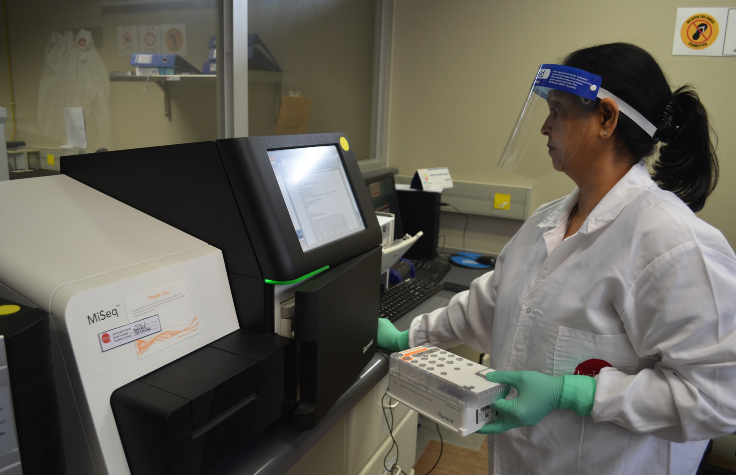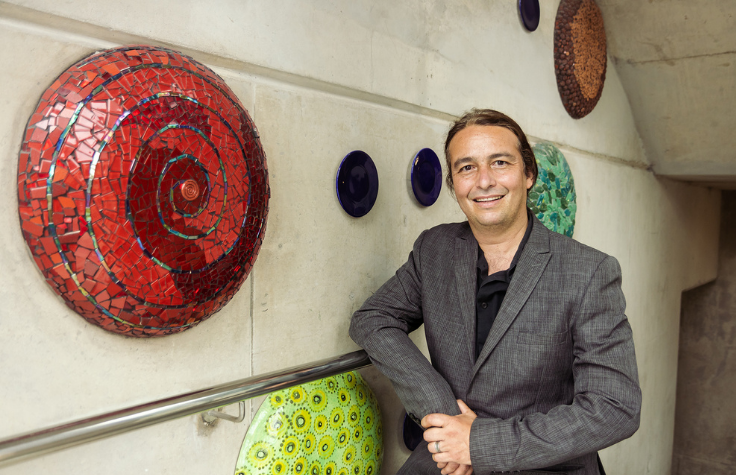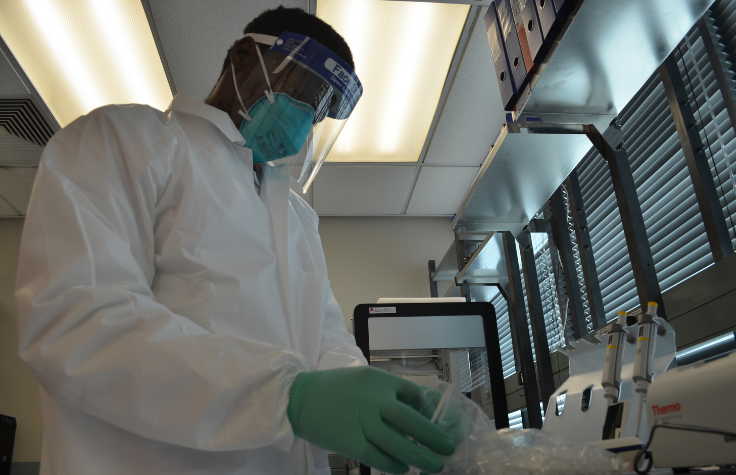
30 September 2021
The African continent is no stranger to epidemics, and carries the biggest pathogen burden in the world —over 140 infectious disease outbreaks are detected each year. Examples of recent outbreaks include Ebola, Chikungunya, Dengue fever, Rift Valley fever, Yellow fever and Lassa fever. Africa has also suffered greatly in the COVID-19 pandemic with 8.2 million cases reported to date, and now the new wave driven by the delta variant. One key difference with the SARS-CoV-2 pathogen is that because it has impacted the rest of the world, sharp attention is now being paid to pandemic preparedness and the role of next-generation sequencing (NGS) technology in pathogen genomics surveillance within that framework. As a result, Africa is undergoing its largest genomics capability build ever—one that will help it fight not only the COVID-19 pandemic, but the relentless number of epidemics it has to take in its stride.
As a vital part of the emerging global pandemic surveillance system, genomics provides the ability to track viral mutations and act as an early warning system for new variants with the potential to evade immunity from vaccines or natural infection. Prior to COVID-19, genomics in Africa was in its gestation, confined to a few research laboratories. At the start of the pandemic, only a few African institutions were able to sequence SARS-CoV-2 positive samples, and on other continents, it was the rapid and substantial demand for healthcare solutions that led to increased investment from governments and non-governmental organizations, placing genomic surveillance at the forefront of the COVID-19 response in Africa.
Using pathogen genomic surveillance as a public health tool
Africa is gearing up. This September saw the launch of the Centre for Epidemic Response and Innovation (CERI) in South Africa, a large genomics facility established with support of Dr Patrick Soon-Shiong and NantAfrica, a division of NantWorks, which will strengthen and innovate pathogen surveillance and response to epidemics and pandemics across Africa. The goal of CERI is to make the continent a leader in identifying pathogens and monitoring for emerging threats before they become pandemics.

Professor Tulio de Oliveira, founding director of CERI and professor at the Universities of Stellenbosch and KwaZulu-Natal, highlights the bold ambition for the future. “It is important for the African continent to have a large genomics facility with the latest cutting-edge technology needed to lead in genomics surveillance. We want to generate our own data at the same price, quality and speed as in Europe, US and Asia.”
Illumina believes strongly in the democratization of sequencing, such that all countries have equal access and equity in genomics. Willy Pena Buttner, Executive Partner Account Manager at Illumina, says: “Thanks to our channel partner, Separations in South Africa, Illumina is delighted to have been able to support the CERI program to apply genomics in real-time to trace and respond to epidemics and pandemics in Africa.”
“It is important for the African continent to have a large genomics facility with the latest cutting-edge technology to lead in genomics surveillance. We want to generate our own data at the same price, quality and speed as in Europe, US and Asia."
CERI joins other facilities such as KRISP (KwaZulu-Natal Research Innovation and Sequencing Platform) and Professor Christian Happi’s team at ACEGID (African Center of Excellence for Genomics in Infectious Diseases) in Ede, Nigeria, who have been using expertise gleaned from fighting infectious disease outbreaks to carrying out sequencing on SARS-CoV-2. So far, Africa has successfully managed to identify many of the variants of concern (VOCs) and variants of interest (VOIs) that are being transmitted across the world. The expansion of genomic surveillance has also been used to make decisions about stopping use of the Oxford/AstraZeneca vaccine after evidence showed it had minimal efficacy against the variant known as B.1.351 prevalent across Africa.
KRISP, ACEGID and now CERI, in addition to the commercial entities company 54Gene, are among the few highly specialized genomics facilities in Africa able to provide fast and affordable genomic data. The Africa Centres for Disease Control and Prevention (CDC), the public health agency of the African Union, has been expanding the network of institutions with NGS capabilities to empower countries to rapidly characterize SARS-CoV-2 outbreak samples, without the need to ship samples across borders. Regional centers such as South Africa’s National Institute for Communicable diseases (NICD), Kenya Medical Research Institute (KEMRI) and the Pasteur Institute in Senegal provide pandemic response in their own and neighboring countries. The national public health institutes and laboratories for the 54 member states of the African Union, over time, will focus on dealing quickly with local outbreaks and epidemics.
An epidemiology study by CERI experts, recently published in Science, describes the unfolding of the SARS-CoV-2 pandemic in Africa. The data suggest a strong linkage between Europe and Africa, with nearly two-thirds of viral imports originating in Europe. As the pandemic has progressed, and with easing of travel restrictions, transmission in many African countries led to the emergence and spread of many VOIs and VOCs.
De Oliveira is excited that the high-throughput Illumina sequencing technology at CERI will not only decrease turnaround time between identifying variants and genetic diversity but also enable a holistic approach to preparing for future pandemics. This holistic approach is welcomed by the Africa CDC and the WHO Regional Office for Africa (AFRO). “We are passionate about enabling sequencing for infectious diseases to become widespread in Africa by ensuring we can train hundreds, if not thousands, of scientists so they can establish sequencing efforts using high-throughput sequencing technologies in their own countries,” de Oliveira says.
With support from the Rockefeller Foundation, CERI has created the Genomics Africa Fellowship program to provide a support system for upskilling the scientific workforce, with around 100 fellows from over 12 countries being welcomed by CERI this year.
Additionally, the Foundation is helping CERI to coordinate sampling across Africa; it is already receiving samples from 10 different African countries. One important fact that much of the world is unaware of, explains de Oliveira, is that Africa has one of the most advanced sample transportation systems. “And the reason is simple—many countries use the big pathology labs such as those in South Africa, Nigeria, Kenya, and Uganda for doing common pathogen testing and diagnostics, and because of the short turnaround time for these, a good network has been established for sample movement,” remarks de Oliveira. “One thing that helps a lot is that export permits are more straightforward if the samples stay in the continent compared with what used to happen a couple of decades ago when genomics samples would have to leave the continent.”

Looking to the future
The African genome is the oldest human genome, with Africa containing more genetic diversity than any other continent. Despite this, fewer than three per cent of analyzed genomes come from Africans, making it a very rich potential source of new genetic information for health and diagnostic research and development. Strengthening capacity for NGS, the preferred technology for pathogen surveillance, is crucial in enabling the African ecosystem to better respond to current and future disease threats and, in turn, can also benefit the world—a pathogen threat in one place can quickly become a threat everywhere.
In addition, the continent faces the growing incidence of non-communicable diseases such as cancer, cardiovascular diseases, and other lifestyle conditions, creating the “double disease burden” across the continent—a considerable challenge for health systems as they try to achieve sustainable development goals.
“As a relative newcomer to NGS, Africa has the opportunity to leapfrog healthcare progress by making genomics standard of care. It has the potential to address the many healthcare challenges, especially around patient loss to therapy, in managing infectious diseases like tuberculosis and HIV. It also has the potential to implement early warning systems and early cancer detection,” says Bridget Mogale, Country Manager, Africa at Illumina.


